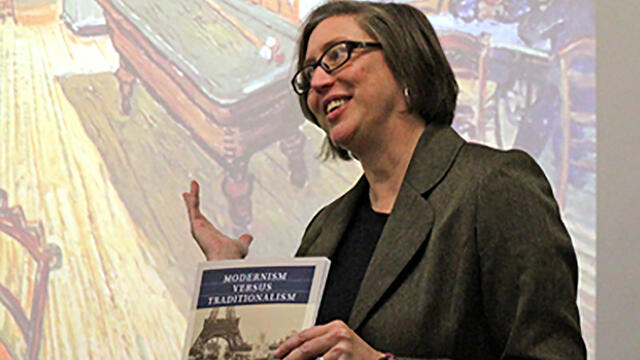McDaniel professor publishes Reacting to the Past game focused on art history
Art History professor Gretchen McKay marked a milestone in early March when she introduced her “Art in Paris” Reacting to the Past game to her Experiencing History class — it was the first time she’s introduced the game to a class with published books in hand.

Art History professor Gretchen McKay marked a milestone in early March when she introduced her “Art in Paris” Reacting to the Past game to her Experiencing History class — it was the first time she’s introduced the game to a class with published books in hand.
Art History professor Gretchen McKay marked a milestone in early March when she introduced her “Art in Paris” Reacting to the Past game to her Experiencing History class — it was the first time she’s introduced the game to a class with published books in hand.
Dozens of classes across the country and here on the Hill have played “Modernism vs. Traditionalism: Art in Paris, 1888-89” in the nine years since McKay began developing the now published game as a way of including art history in the selection. Originated in the late 1990s at Barnard College, Reacting to the Past prompts students to research and reenact events in the past — active learning that leads to better understanding and retention.
“I wrote this for my teaching — to use my scholarship to affect my students and their learning,” says McKay, an early adopter of Reacting to the Past pedagogy who always believed that art had a place in the Reacting library. “Art history is all about context. Van Gogh didn’t burst onto the scene and sell paintings like his work sells now.”
As the name suggests, “Art in Paris” centers on art in the late 19th century when Paris was the mecca of the art world and modernism and traditionalism were vying for the approval of the powerful Academy. The game opens in 1888, during the final days of the Salon, the major art event of the year.
It is a time of great upheaval with traditionalists such as Édouard Detaille and his Medal of Honor painting “The Dream” competing with Impressionists Claude Monet and August Renoir as well as the real outliers of the times, the Avant-garde artists like Gauguin and Van Gogh, who were trying to push art into an entirely new direction. The game reaches a finale in the 1889 World Exposition held in Paris with artists, critics and dealers representing the various art factions.
“‘Art in Paris’ offers students an opportunity to experience by immersing in the Parisian art world of 1889, to view, describe and debate the full range of artistic styles and movements at play during that time,” says McKay. “The game helps students understand the power struggles and difficulties inherent in any effort to change a system while simultaneously attempting to be included in it.”
McKay’s students first played the game in April of 2010 after she spent most of spring break writing the role sheets for the 21 characters then in the game. It worked, she says, but she immediately started tweaking and refining to fix any minor problems she came across.
Honors student Rachel Wojnar played an art critic when she played the unpublished game in McKay’s Romanticism and Impressionism class and looks forward to seeing the turbulent times through a new perspective in a different role this time around.
“At first it was a strange experience but Dr. McKay really immersed us in the material,” says Wojnar, a senior Art and Art History double major from Cumberland, Md. “The game was the culminating experience that settled in everything we learned and helped us hold onto the ideas and information.”
Today, in addition to the 50-page game plan the students use, there is also a 200+-page Instructor’s Manual that includes four- to five-page role sheets for 28 characters — artists, dealers and critics. McKay collaborated with Nicolas Proctor, a professor at Simpson College, on game design and credits him with helping her “game it up.”
Michael Marlais, McKay’s undergrad advisor and a professor emeritus at Colby College, lent his expertise in 19th century art criticism, some of which was translated for the first time by Marlais.
As “Art in Paris” was vetted for publication, Reacting to the Past granted permission for 37 classes — representing 1,060 students — at 25 institutions to play the game. It’s been played at nearly 20 more colleges and universities as well as at several regional and national conferences.
And that’s just the beginning since the “Art in Paris” is published and readily available for purchase.
“I’m very proud of it, of course,” says McKay. “But it is much more important to me that through ‘Art in Paris,’ I will be affecting the lives of thousands of students.”
Art History professor Gretchen McKay introduces her Experiencing History Honors class to her recently published Reacting to the Past game, "Modernism vs. Traditionalism: Art in Paris, 1888-89."